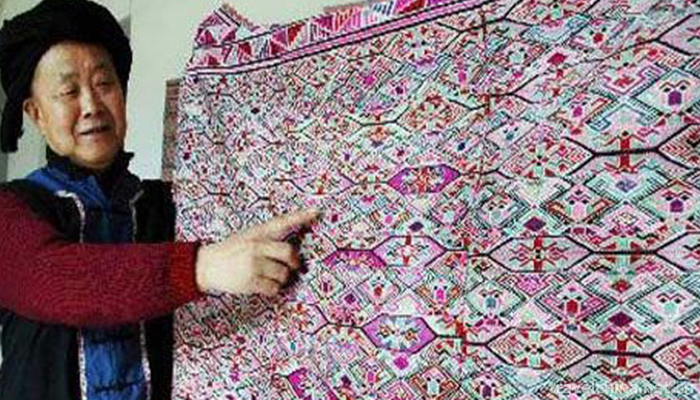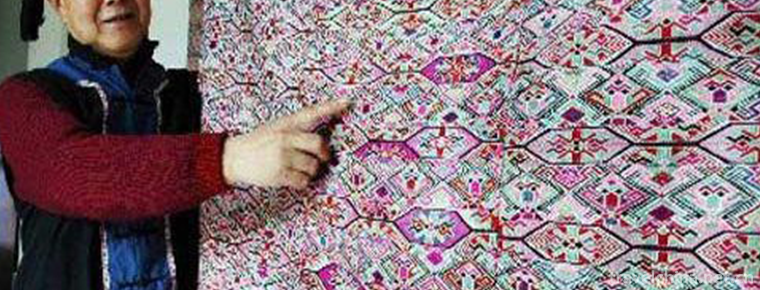Brocade Weaving Skills of Tujia Nationality
Brocade Weaving Skills of Tujia Nationality
Tujia brocade weaving skills. The traditional handicraft of Tujia and Miao Autonomous Prefecture in Western Hunan Province is one of the national intangible cultural heritages.
Tujia brocade weaving process is complex, in weaving, using the ancient pure wooden waist inclined loom weaving, through spinning and twisting, dyeing, inverting, drawing, reed loading, rolling, picking up, turning pole, picking up flowers, baling pole, weaving, pick-up weaving and other 12 processes.
On May 20, 2006, Tujia brocade weaving technology was approved by the State Council and listed in the first batch of national intangible cultural heritage list, project number_-6.
historical origin
The brocade weaving technique of Tujia nationality in Western Hunan has a long history. It has a history of more than 1500 years since its formation. It can be traced back at least to the ancient times of more than 4000 years ago. As the ancestors of the Tujia nationality, the ancient Pakistanis were good at textile besides agricultural production, and their "silkworm" and "hemp" even became tribute. In the Qin and Han Dynasties, the textile industry in Tujia area developed, and the Tujia ancestors paid taxes by cloth. During the Three Kingdoms Period, the people of Tujia nationality gradually mastered the advanced dyeing technology of Han nationality and weaved colorful "Tujin".
With the increase of economic exchanges between Tujia and Han nationality in Tang and Song Dynasties, the textile industry in Tujia nationality area developed further, and the social atmosphere of "women are diligent in weaving, households are multi-machine voice" appeared. At that time, the "cloth" of Tujia nationality was called "Xibu", "Dongbu" or "Dongjin" by Han people.
During the reign of Tusi in Yuan, Ming and Qing Dynasties, silk, cotton, cotton, Tung quilt, Tung towel, and colorful were used by Tujia ancestors in Hunan and Hubei, "as cranes, phoenixes, flowers and birds". Xiushan, Youyang and Qianjiang in Sichuan take linen as their clothes. "Daming Unified Records" contains: "The local people like to wear five-color striped clothes." Xilankapu is the best brocade of "Xibu". It is a tribute to the court with more than 200 designs. It is made of silk, cotton, linen, wool and other raw materials, generally red, blue and blue (black) cotton yarn as warp, freely choosing cotton yarn, silk yarn or wool as weft, using ancient wooden loom, flower picking knife (made of bamboo and ox bone), by hand pick weaving through the reverse side of warp and weft breaking.
During the Ming and Qing Dynasties, the technology of the brocade was further developed. The brocade was called "Tujin" and "Flower Cloth" and was widely used in costumes, gradually forming a unique brocade weaving process. Yongding County Chronicle compiled during Tongzhi reign of Qing Dynasty also said: "For it, the local meridians are colorful and lovely. They are used as quilts, dresses or towels, so they are also called"cylinder scarves". After returning home, the picking and weaving skills of the Tujia New Zealand Kappa have been further improved. Especially the Tujia girls, who have practiced picking and weaving skills with their mothers and sisters since childhood. When the girls grow up and marry, they must also have their own picking and weaving bronze Kappa as a dowry, as well as the children's quilt, skirt and backpack in the cradle of the married children, all of which have to be knitted by the girls themselves. Therefore, this technology can be carried forward. Since then, this brocade technique has been handed down from generation to generation.
Technological characteristics
Pattern
The design theme of Xilankapu is extensive, covering almost every aspect of Tujia people's life. There are more than 200 basic stereotyped traditional patterns, including flowers, birds, fish and insects, scenery of mountains and rivers, auspicious words, folk stories, fables and other pictures. The choice of theme is closely related to Tujia people's life and customs. The design pattern of Xilankapu includes natural image pattern, geometric pattern and text pattern. The style of these decorative patterns is based on the original geometric patterns, cloud patterns of Han Dynasty, peony of Tang Dynasty, pine, bamboo and plum of Yuan Dynasty, and string lotus of Ming Dynasty.
Romantic generalization, distortion and exaggeration are often used in the composition, which integrates various dynamic and static forms, natural patterns and geometric patterns skillfully, making the whole pattern not only full of life interest, but also with distinct national characteristics.
color
The color of the design is bright and warm. It likes to use contrasting colors and black-and-white backing hooks. All kinds of hook, zigzag, comb, suture, chain edge ornaments, plus a variety of polygonal flowers as ornaments, and black substrate, with white edge. As a result, the primary and secondary patterns appear to be both distinct boundaries and integrated because of the contrast between black and white.
In the use of colours, Zelankapp has not only a strong contrast of colorful colors in Tang Dynasty, but also a simple, elegant and generous tone harmony in Qing Dynasty. Tujia people advocate red and black, because red is warm, representing light, black is cold, symbolizing solemnity, so the Kappa of Zealand is mainly red, supplemented by black, interspersed by yellow, blue and white.
Inheritance and Protection
Inheritance value
More than 400 traditional patterns and patterns of Tujia brocade are the unique manifestations of Tujia's national cultural psychology and cultural accumulation of different times. They fully demonstrate Tujia's creativity and have positive testimony significance for the formation and development of Chinese multi-culture.
Current situation of inheritance
With the change of society, economic structure and cultural consciousness, Tujia brocade weaving technology is gradually losing the soil and environment on which it depends to survive, and is in an all-round endangered situation. Strong measures are urgently needed to be taken to protect it.
Heritage figures
Ye Shuiyun, female, Tujia nationality, born in October 1968 in Yejiazhai, Miaoertan Town, Longshan County, Hunan Province. In June 2007, Ye Shuiyun was selected as the representative successor of the first batch of national intangible cultural heritage projects and declared in Xiangxi Shijia Miao Autonomous Prefecture of Hunan Province.
Liu Dai'e, female, Tujia nationality, born in December 1955, is a native of Laoche River Village, Miaoertan Town, Longshan County, Hunan Province. In June 2007, Liu Dai'e was selected as the representative successor of the first batch of national intangible cultural heritage projects and declared by Tujia and Miao Autonomous Prefecture in Western Hunan Province.
protective measures
With the support of the Longshan County Committee and the county government, Liu Dai'e, a non-hereditary inheritor of Tujia brocade, organized Tujia Brocade Heritage Institute in the village of Laoche River to teach women in the village to learn brocade art.
On September 10, 2015, Longshan County held the unveiling test of the intangible cultural heritage production protection base of Qiumei Tujia Brocade Co., Ltd., which marked that the national intangible cultural heritage, Tujia Brocade, had a special inheritance, development and production base since then, and the traditional national culture has a new development path.
social influence
Important Exhibitions
On December 20, 2017, the "Xilankapu-China Tujia Brocade Culture Exhibition" co-sponsored by the Museum of Nationalities of China and the Museum of Women and Children of China and co-sponsored by the Zhangjiajie Municipal Government Office in Beijing was officially launched in the Museum of Women and Children of China, and Tujia brocade weaving skills were displayed.
On June 25, 2018, the launching ceremony of "Beautiful Xiangxi Splendid Tujia - Tujia Brocade Exhibition" was held at the Museum of Textile and Clothing College, in which Tujia brocade skills were displayed.
Cultural anecdotes
Legend has it that in the early years of the Tujia people there was a skillful hand named Xilan who knitted the quilt. She is skillful and skillful in brocade weaving, so long as she sees some kind of flower, she can weave it on the surface of the quilt. Flowers within a hundred miles of her hometown were woven into the quilt by her, but the white fruit flower she had never seen, could not be woven into the quilt. Because the white fruit flower is "flowering in Yinshi and declining in Mao Shi", the flowering period is short, she has no chance to see it. In order to collect the patterns of white fruit flowers, she wakes up at childhood for several days, combs and dresses, and waits for Yinshi to come under the white fruit tree. This aroused the suspicion of the father of the girl in Zealand that she was waiting for her lover when she was dressed up under the white fruit tree. Fearing that being seen gossiping in the village would hinder the family's dignity, his father killed the girl in a moment of confusion when he was drunk. At dawn, his father woke up and regretted, but he could not recover his mistake. The death of a girl in Zealand is an irreparable loss to the Tujia people. When the villagers miss her, they call her knitted earthen flower quilt "Zelankap". Thereafter, every Tujia girl had to weave two beds of "Celanka Po" herself as dowry before she got married, in order to miss Celanese girls.


-
1.Chill chicken rice noodles
Cold chicken noodles, Yunnan snacks, cold rice noodles with ...
Time 2018-10-17 -
2.Changchun Movie Wonderland
Changchun Movie Wonderland, located in Nanguan District, Changchun City, Jilin Province, was founded in 2003. It is a comprehensive tourist area integrating science and technology
Time 2018-12-05 -
3.Tiantangzhai Tourist Scenic Area
Tiantangzhai (National AAAAA Tourist Scenic Spot, National Nature Reserve, National Forest Park and National Geological Park) is the second peak of the Dabie Mountains
Time 2018-12-08 -
4.Yellow River First BeachTime 2018-12-22
-
5.Buddhist Cultural Tourist Area of Great Buddha and Zen Temple
As the first door to worship Mount Emei, the Buddha Zen Temple is the first stop to pray and worship in Emei, and it is also a must-go place. The Grand Buddha Temple, formerly known as the Grand Buddh
Time 2019-01-06 -
6.Lushan National Forest Park
Located in the center of Shandong Province, Lushan National Forest Park is an important scenic spot of Boshan Scenic Tourist Area, with its main peak at 1108.3 meters above sea level, the highest peak
Time 2019-02-06 -
7.Firing Techniques of Jizhou Kiln Ceramics
Jizhou kiln is a treasure of the traditional Chinese ceramic crafts. As a world-famous comprehensive ceramic kiln in Jiangnan (Ji'an, Jiangxi), it has strong local style
Time 2019-05-05 -
8.Shaoxing Pinghu Tune
Shaoxing Pinghu Diao, also known as "Yuejun Nanci", or "Shaoxing Pinghu Diao" for short, is a popular form of folk art in Shaoxing and its surrounding areas in Zhejiang Province. I
Time 2019-06-14 -
9.Legend of bald tailed Lao Li
Folk legends of bald-tailed Lao Li are widely circulated in Shandong Province, and similar written records are found in Yuan Mei's Zi Yu of the Qing Dynasty: "Bi Shifu, Wendeng County, Shandong P
Time 2019-06-23 -
10.Chengdu University
Chengdu University, established in 1978 with the approval of the Ministry of Education, is a comprehensive University jointly built by Sichuan Province and Chengdu City. It is a key comprehensive univ
Time 2019-08-31 -
11.Collection value of Chinese embroidery
Mr. Chen, a fan of antique collection, bought a silk embroidery at Fuzhou flea market for more than 10000 yuan 19 years ago, which is worth at least 300000 yuan by 2008. This embroidery, about 1.8 meters long, has a dark red background, with butterfly
Time 2020-12-12 -
12.Social undertakings in Luzhou
As of the end of 2018, Luzhou has added 1 provincial key laboratory, 1 provincial engineering technology research center, 4 incubators of science and technology enterprises above the provincial level, and 16 national high-tech enterprises. The annual output value of high-tech reached 38
Time 2020-12-14